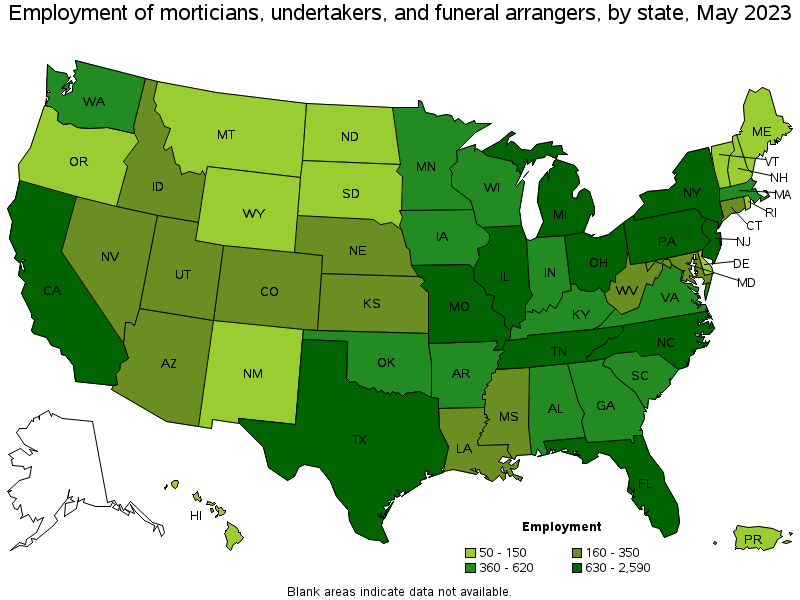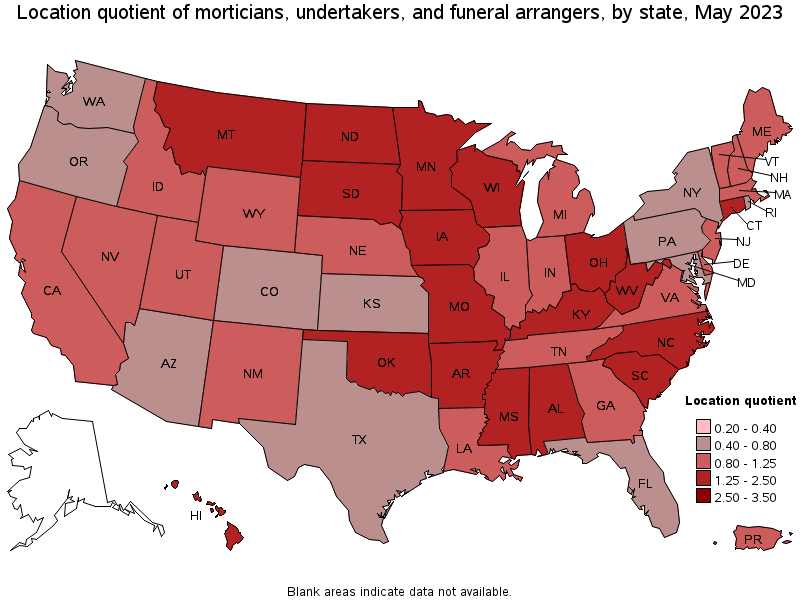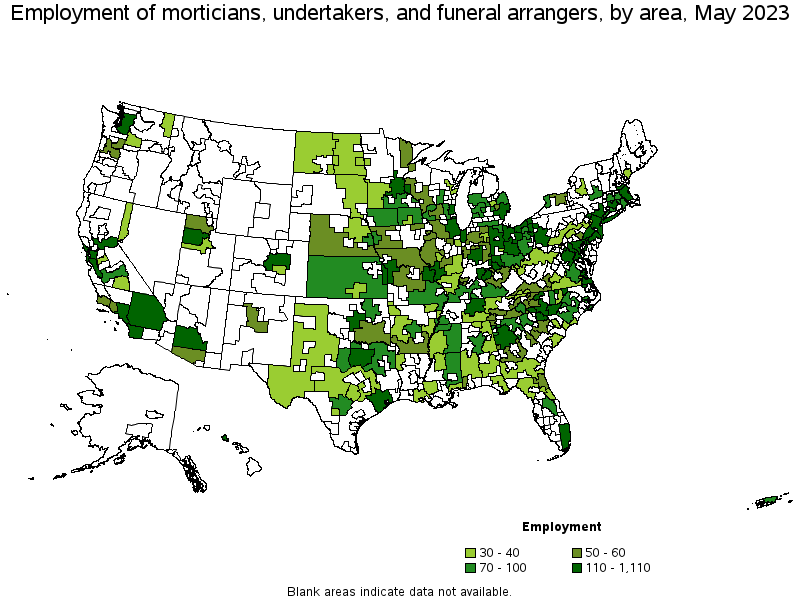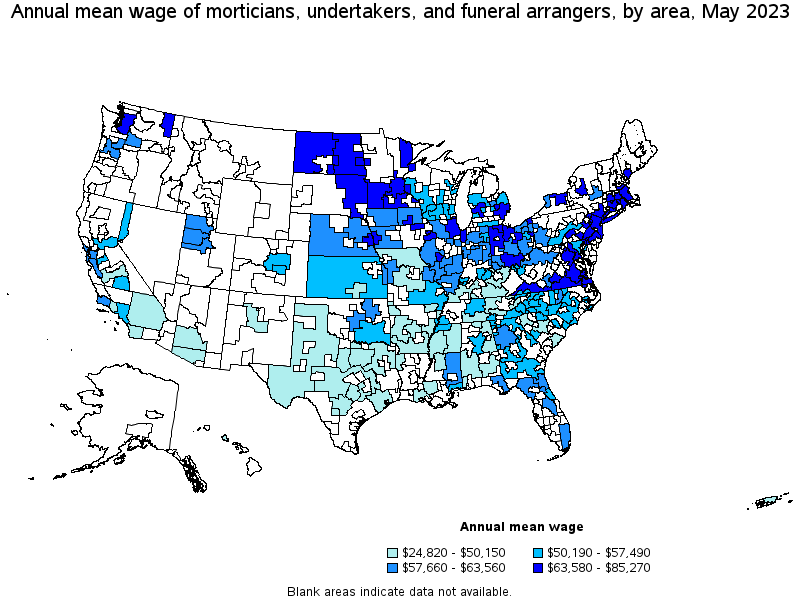An official website of the United States government
 United States Department of Labor
United States Department of Labor
Perform various tasks to arrange and direct individual funeral services, such as coordinating transportation of body to mortuary, interviewing family or other authorized person to arrange details, selecting pallbearers, aiding with the selection of officials for religious rites, and providing transportation for mourners. Excludes “Funeral Home Managers” (11-9171).
Employment estimate and mean wage estimates for Morticians, Undertakers, and Funeral Arrangers:
| Employment (1) | Employment RSE (3) |
Mean hourly wage |
Mean annual wage (2) |
Wage RSE (3) |
|---|---|---|---|---|
| 24,200 | 2.8 % | $ 27.90 | $ 58,020 | 1.1 % |
Percentile wage estimates for Morticians, Undertakers, and Funeral Arrangers:
| Percentile | 10% | 25% | 50% (Median) |
75% | 90% |
|---|---|---|---|---|---|
| Hourly Wage | $ 14.74 | $ 18.90 | $ 24.53 | $ 34.28 | $ 44.17 |
| Annual Wage (2) | $ 30,660 | $ 39,320 | $ 51,030 | $ 71,300 | $ 91,870 |
Industries with the highest published employment and wages for Morticians, Undertakers, and Funeral Arrangers are provided. For a list of all industries with employment in Morticians, Undertakers, and Funeral Arrangers, see the Create Customized Tables function.
Industries with the highest levels of employment in Morticians, Undertakers, and Funeral Arrangers:
| Industry | Employment (1) | Percent of industry employment | Hourly mean wage | Annual mean wage (2) |
|---|---|---|---|---|
| Death Care Services | 23,910 | 17.42 | $ 27.79 | $ 57,800 |
| Federal, State, and Local Government, excluding State and Local Government Schools and Hospitals and the U.S. Postal Service (OEWS Designation) | 160 | 0.01 | $ 42.49 | $ 88,390 |
| Colleges, Universities, and Professional Schools | 40 | 0.00 | $ 37.88 | $ 78,790 |
Industries with the highest concentration of employment in Morticians, Undertakers, and Funeral Arrangers:
| Industry | Employment (1) | Percent of industry employment | Hourly mean wage | Annual mean wage (2) |
|---|---|---|---|---|
| Death Care Services | 23,910 | 17.42 | $ 27.79 | $ 57,800 |
| Federal, State, and Local Government, excluding State and Local Government Schools and Hospitals and the U.S. Postal Service (OEWS Designation) | 160 | 0.01 | $ 42.49 | $ 88,390 |
| Colleges, Universities, and Professional Schools | 40 | 0.00 | $ 37.88 | $ 78,790 |
Top paying industries for Morticians, Undertakers, and Funeral Arrangers:
| Industry | Employment (1) | Percent of industry employment | Hourly mean wage | Annual mean wage (2) |
|---|---|---|---|---|
| Federal, State, and Local Government, excluding State and Local Government Schools and Hospitals and the U.S. Postal Service (OEWS Designation) | 160 | 0.01 | $ 42.49 | $ 88,390 |
| Colleges, Universities, and Professional Schools | 40 | (7) | $ 37.88 | $ 78,790 |
| Death Care Services | 23,910 | 17.42 | $ 27.79 | $ 57,800 |
States and areas with the highest published employment, location quotients, and wages for Morticians, Undertakers, and Funeral Arrangers are provided. For a list of all areas with employment in Morticians, Undertakers, and Funeral Arrangers, see the Create Customized Tables function.

States with the highest employment level in Morticians, Undertakers, and Funeral Arrangers:
| State | Employment (1) | Employment per thousand jobs | Location quotient (9) | Hourly mean wage | Annual mean wage (2) |
|---|---|---|---|---|---|
| California | 2,590 | 0.14 | 0.91 | $ 25.26 | $ 52,550 |
| Ohio | 1,790 | 0.33 | 2.05 | $ 30.24 | $ 62,900 |
| Texas | 1,150 | 0.08 | 0.53 | $ 15.89 | $ 33,040 |
| New York | 1,040 | 0.11 | 0.70 | $ 35.08 | $ 72,970 |
| North Carolina | 1,010 | 0.21 | 1.33 | $ 26.41 | $ 54,920 |

States with the highest concentration of jobs and location quotients in Morticians, Undertakers, and Funeral Arrangers:
| State | Employment (1) | Employment per thousand jobs | Location quotient (9) | Hourly mean wage | Annual mean wage (2) |
|---|---|---|---|---|---|
| Iowa | 560 | 0.36 | 2.28 | $ 31.13 | $ 64,750 |
| Arkansas | 420 | 0.33 | 2.10 | $ 21.41 | $ 44,540 |
| Ohio | 1,790 | 0.33 | 2.05 | $ 30.24 | $ 62,900 |
| North Dakota | 130 | 0.32 | 2.02 | $ 37.41 | $ 77,810 |
| Kentucky | 610 | 0.31 | 1.96 | $ 21.97 | $ 45,700 |

Top paying states for Morticians, Undertakers, and Funeral Arrangers:
| State | Employment (1) | Employment per thousand jobs | Location quotient (9) | Hourly mean wage | Annual mean wage (2) |
|---|---|---|---|---|---|
| Rhode Island | 50 | 0.09 | 0.59 | $ 40.44 | $ 84,120 |
| Minnesota | 600 | 0.21 | 1.30 | $ 40.38 | $ 83,990 |
| North Dakota | 130 | 0.32 | 2.02 | $ 37.41 | $ 77,810 |
| Delaware | 80 | 0.16 | 1.02 | $ 36.31 | $ 75,530 |
| Connecticut | 350 | 0.21 | 1.31 | $ 35.43 | $ 73,690 |

Metropolitan areas with the highest employment level in Morticians, Undertakers, and Funeral Arrangers:
| Metropolitan area | Employment (1) | Employment per thousand jobs | Location quotient (9) | Hourly mean wage | Annual mean wage (2) |
|---|---|---|---|---|---|
| New York-Newark-Jersey City, NY-NJ-PA | 1,110 | 0.12 | 0.73 | $ 35.75 | $ 74,360 |
| Los Angeles-Long Beach-Anaheim, CA | 910 | 0.15 | 0.93 | $ 25.19 | $ 52,380 |
| Chicago-Naperville-Elgin, IL-IN-WI | 510 | 0.11 | 0.70 | $ 36.05 | $ 74,990 |
| Boston-Cambridge-Nashua, MA-NH | 320 | 0.12 | 0.73 | $ 34.76 | $ 72,300 |
| Houston-The Woodlands-Sugar Land, TX | 320 | 0.10 | 0.62 | $ 16.75 | $ 34,840 |
| Detroit-Warren-Dearborn, MI | 320 | 0.17 | 1.04 | $ 31.78 | $ 66,100 |
| San Francisco-Oakland-Hayward, CA | 310 | 0.13 | 0.81 | $ 28.02 | $ 58,290 |
| St. Louis, MO-IL | 310 | 0.23 | 1.47 | $ 30.17 | $ 62,750 |
| Cleveland-Elyria, OH | 310 | 0.31 | 1.94 | $ 29.91 | $ 62,210 |
| Miami-Fort Lauderdale-West Palm Beach, FL | 300 | 0.11 | 0.70 | $ 29.70 | $ 61,770 |

Metropolitan areas with the highest concentration of jobs and location quotients in Morticians, Undertakers, and Funeral Arrangers:
| Metropolitan area | Employment (1) | Employment per thousand jobs | Location quotient (9) | Hourly mean wage | Annual mean wage (2) |
|---|---|---|---|---|---|
| Springfield, OH | 40 | 0.81 | 5.06 | $ 28.24 | $ 58,740 |
| Youngstown-Warren-Boardman, OH-PA | 110 | 0.56 | 3.50 | $ 29.47 | $ 61,300 |
| Duluth, MN-WI | 60 | 0.49 | 3.07 | $ 35.62 | $ 74,080 |
| Florence, SC | 40 | 0.43 | 2.70 | $ 25.43 | $ 52,900 |
| Yakima, WA | 40 | 0.42 | 2.61 | $ 27.72 | $ 57,660 |
| Saginaw, MI | 30 | 0.41 | 2.56 | $ 30.56 | $ 63,560 |
| Canton-Massillon, OH | 70 | 0.40 | 2.53 | $ 27.20 | $ 56,570 |
| Hickory-Lenoir-Morganton, NC | 60 | 0.40 | 2.49 | $ 25.68 | $ 53,400 |
| Asheville, NC | 80 | 0.39 | 2.47 | $ 26.77 | $ 55,680 |
| Cedar Rapids, IA | 50 | 0.39 | 2.45 | $ 30.95 | $ 64,380 |

Top paying metropolitan areas for Morticians, Undertakers, and Funeral Arrangers:
| Metropolitan area | Employment (1) | Employment per thousand jobs | Location quotient (9) | Hourly mean wage | Annual mean wage (2) |
|---|---|---|---|---|---|
| Minneapolis-St. Paul-Bloomington, MN-WI | 280 | 0.15 | 0.93 | $ 41.00 | $ 85,270 |
| Fargo, ND-MN | 30 | 0.22 | 1.40 | $ 38.28 | $ 79,620 |
| Bridgeport-Stamford-Norwalk, CT | 90 | 0.22 | 1.35 | $ 37.29 | $ 77,570 |
| Chicago-Naperville-Elgin, IL-IN-WI | 510 | 0.11 | 0.70 | $ 36.05 | $ 74,990 |
| Rochester, NY | 60 | 0.12 | 0.74 | $ 35.77 | $ 74,410 |
| New York-Newark-Jersey City, NY-NJ-PA | 1,110 | 0.12 | 0.73 | $ 35.75 | $ 74,360 |
| Duluth, MN-WI | 60 | 0.49 | 3.07 | $ 35.62 | $ 74,080 |
| Hartford-West Hartford-East Hartford, CT | 110 | 0.19 | 1.19 | $ 35.49 | $ 73,830 |
| Davenport-Moline-Rock Island, IA-IL | 50 | 0.30 | 1.90 | $ 35.29 | $ 73,400 |
| Allentown-Bethlehem-Easton, PA-NJ | 40 | 0.10 | 0.65 | $ 34.84 | $ 72,460 |
Nonmetropolitan areas with the highest employment in Morticians, Undertakers, and Funeral Arrangers:
| Nonmetropolitan area | Employment (1) | Employment per thousand jobs | Location quotient (9) | Hourly mean wage | Annual mean wage (2) |
|---|---|---|---|---|---|
| North Northeastern Ohio nonmetropolitan area (noncontiguous) | 190 | 0.58 | 3.64 | $ 31.46 | $ 65,430 |
| Piedmont North Carolina nonmetropolitan area | 120 | 0.48 | 3.00 | $ 27.64 | $ 57,490 |
| West Northwestern Ohio nonmetropolitan area | 110 | 0.43 | 2.67 | $ 31.27 | $ 65,050 |
| South Central Kentucky nonmetropolitan area | 100 | 0.60 | 3.73 | $ 20.64 | $ 42,930 |
| Southeast Coastal North Carolina nonmetropolitan area | 90 | 0.38 | 2.38 | $ 26.32 | $ 54,740 |
Nonmetropolitan areas with the highest concentration of jobs and location quotients in Morticians, Undertakers, and Funeral Arrangers:
| Nonmetropolitan area | Employment (1) | Employment per thousand jobs | Location quotient (9) | Hourly mean wage | Annual mean wage (2) |
|---|---|---|---|---|---|
| Northeast Iowa nonmetropolitan area | 70 | 0.69 | 4.32 | $ 29.02 | $ 60,360 |
| East Arkansas nonmetropolitan area | 40 | 0.66 | 4.17 | $ 20.22 | $ 42,060 |
| East North Dakota nonmetropolitan area | 40 | 0.66 | 4.13 | $ 32.35 | $ 67,290 |
| Eastern Ohio nonmetropolitan area | 80 | 0.60 | 3.76 | $ 29.63 | $ 61,630 |
| Southeast Mississippi nonmetropolitan area | 90 | 0.60 | 3.75 | $ 29.22 | $ 60,780 |
Top paying nonmetropolitan areas for Morticians, Undertakers, and Funeral Arrangers:
| Nonmetropolitan area | Employment (1) | Employment per thousand jobs | Location quotient (9) | Hourly mean wage | Annual mean wage (2) |
|---|---|---|---|---|---|
| Southwest Minnesota nonmetropolitan area | 40 | 0.38 | 2.36 | $ 40.97 | $ 85,220 |
| Southeast Minnesota nonmetropolitan area | 80 | 0.53 | 3.31 | $ 40.48 | $ 84,190 |
| West North Dakota nonmetropolitan area | 40 | 0.34 | 2.11 | $ 38.33 | $ 79,720 |
| Southern Ohio nonmetropolitan area | 70 | 0.42 | 2.64 | $ 34.57 | $ 71,910 |
| East North Dakota nonmetropolitan area | 40 | 0.66 | 4.13 | $ 32.35 | $ 67,290 |
These estimates are calculated with data collected from employers in all industry sectors, all metropolitan and nonmetropolitan areas, and all states and the District of Columbia. The top employment and wage figures are provided above. The complete list is available in the downloadable XLS files.
The percentile wage estimate is the value of a wage below which a certain percent of workers fall. The median wage is the 50th percentile wage estimate—50 percent of workers earn less than the median and 50 percent of workers earn more than the median. More about percentile wages.
(1) Estimates for detailed occupations do not sum to the totals because the totals include occupations not shown separately. Estimates do not include self-employed workers.
(2) Annual wages have been calculated by multiplying the hourly mean wage by a "year-round, full-time" hours figure of 2,080 hours; for those occupations where there is not an hourly wage published, the annual wage has been directly calculated from the reported survey data.
(3) The relative standard error (RSE) is a measure of the reliability of a survey statistic. The smaller the relative standard error, the more precise the estimate.
(7) The value is less than .005 percent of industry employment.
(9) The location quotient is the ratio of the area concentration of occupational employment to the national average concentration. A location quotient greater than one indicates the occupation has a higher share of employment than average, and a location quotient less than one indicates the occupation is less prevalent in the area than average.
Other OEWS estimates and related information:
May 2023 National Occupational Employment and Wage Estimates
May 2023 State Occupational Employment and Wage Estimates
May 2023 Metropolitan and Nonmetropolitan Area Occupational Employment and Wage Estimates
May 2023 National Industry-Specific Occupational Employment and Wage Estimates
Last Modified Date: April 3, 2024